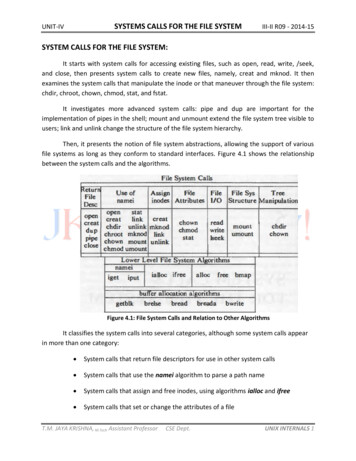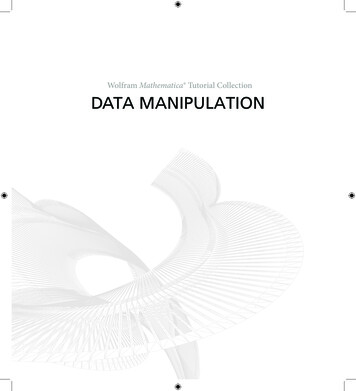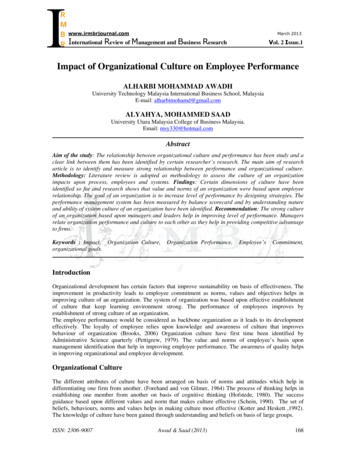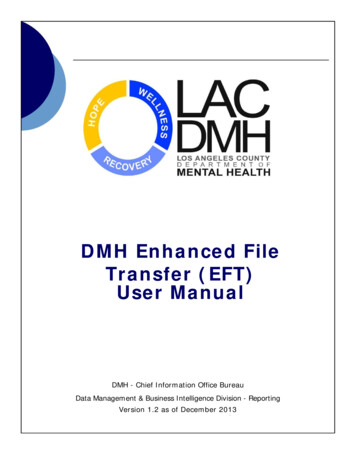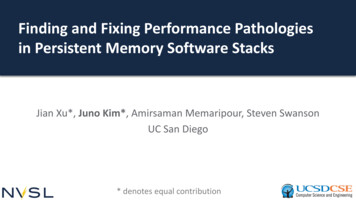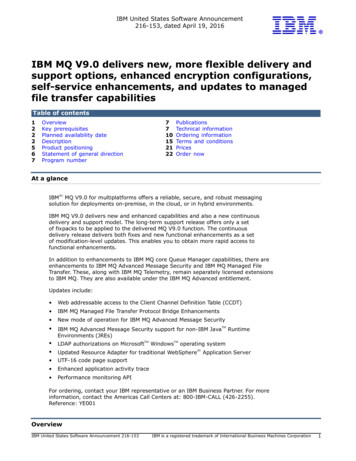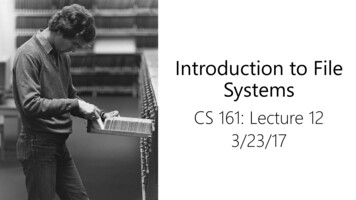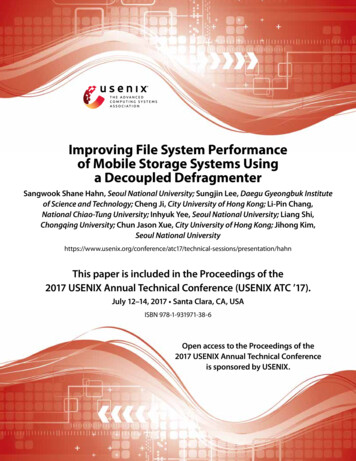
Transcription
Improving File System Performanceof Mobile Storage Systems Usinga Decoupled DefragmenterSangwook Shane Hahn, Seoul National University; Sungjin Lee, Daegu Gyeongbuk Instituteof Science and Technology; Cheng Ji, City University of Hong Kong; Li-Pin Chang,National Chiao-Tung University; Inhyuk Yee, Seoul National University; Liang Shi,Chongqing University; Chun Jason Xue, City University of Hong Kong; Jihong Kim,Seoul National technical-sessions/presentation/hahnThis paper is included in the Proceedings of the2017 USENIX Annual Technical Conference (USENIX ATC ’17).July 12–14, 2017 Santa Clara, CA, USAISBN 978-1-931971-38-6Open access to the Proceedings of the2017 USENIX Annual Technical Conferenceis sponsored by USENIX.
Improving File System Performance of Mobile Storage SystemsUsing a Decoupled DefragmenterSangwook Shane Hahn, Sungjin Lee† , Cheng Ji , Li-Pin Chang‡ ,Inhyuk Yee, Liang Shi§ , Chun Jason Xue , and Jihong KimSeoul National University, † Daegu Gyeongbuk Institute of Science and Technology, City University of Hong Kong, ‡ National Chiao-Tung University, § Chongqing UniversityAbstractStep 1: examine the need and effect ofIn this paper, we comprehensively investigate the filefragmentation problem on mobile flash storage. Fromour evaluation study with real Android smartphones, weobserved two interesting points on file fragmentation onflash storage. First, defragmentation on mobile flashstorage is essential for high I/O performance on Androidsmartphones because file fragmentation, which is a recurring problem (even after defragmentation), can significantly degrade I/O performance. Second, file fragmentation affects flash storage quite differently than HDDs.When files are fragmented on flash storage, the logical fragmentation and the physical fragmentation are decoupled and a performance degradation mostly comesfrom logical fragmentation. Motivated by our observations, we propose a novel defragger, janus defragger(janusd), which supports two defraggers, janusdL for alogical defragger and janusdP for a physical defragger.JanusdL, which takes advantage of flash storage’s internal logical to physical mapping table, supports logicaldefragmentation without data copies. JanusdL is veryeffective for most fragmented files while not sacrificingthe flash lifetime. JanusdP, which is useful for physically fragmented files but requires data copies, is invokedonly when absolutely necessary. By adaptively selectingjanusdL and janusdP, janusd achieves the effect of fullfile defragmentation without reducing the flash lifetime.Our experimental results show that janusd can achieve atleast the same level of I/O performance improvement ase4defrag without affecting the flash lifetime, thus making janusd an attractive defragmentation solution for mobile flash storage.1IntroductionWhen a file system becomes highly fragmented, it hasto allocate multiple split storage areas, i.e., extents [1],for a single file more frequently. In an HDD-based filesystem, accessing such a highly-fragmented file degradesthe performance significantly due to the increased timeconsuming seek operations. In order to mitigate the performance impact caused by file fragmentation, many filesystems recommends the periodical execution of the defragmentation utility (e.g., every week) [2-6].Unlike for HDD-based file systems, defragmentationis generally not recommended for flash-based file systems [7-13]. Since flash storage does not require seekUSENIX Associationfile defragmentation. (See Section 2.)Step 2: extract the design requirements ofa defragger for flash storage. (See Section 3.)Step 3: design and implement a defraggerthat meets the requirements. (See Section 4.)Fig. 1: A summary of the key steps in our investigation.operations, it is believed that the effect of defragmentation on the file system performance is rather negligiblefor flash storage. Furthermore, since a large number offiles need to be copied during defragmentation, frequentdefragmentation can affect the limited lifetime. However, this negative view toward flash defragmentation hasbeen widely accepted without a proper validation study.The main goal of this paper, therefore, is to investigatethe file fragmentation problem on mobile flash storage ina systematic and comprehensive fashion. Fig. 1 summarizes the key steps of our investigation study.Since previous studies (e.g., [22]) have shown that filescan be severely fragmented on mobile flash storage, inour study, we start with two key questions related to theeffect of file defragmentation (step 1 in Fig. 1): 1) whenfragmented files are defragmented, how much I/O performance is improved? and 2) how long does the effectof file defragmentation last? Unlike a common misconception on flash defragmentation, our evaluation studyshowed that I/O performance of flash storage can be significantly improved by defragmentation. For example,when fragmented files were defragmented, the averageapp launching time, which is an important user-perceivedperformance metric on smartphones, can be improved byup to 52% over the fragmented files.Although fragmented files can degrade the I/O performance, if the effect of file defragmentation can last forlong time (e.g., several months), a conventional defragmentation tool will be sufficient. However, our evaluation study indicated that file fragmentation may recur ina short cycle, around a week, even after full file defragmentation on smartphones. One main cause of recurringfile fragmentation was frequent automatic app updateson smartphones. Since many popular apps tend to be updated very frequently (e.g., every 10 days [28]), the effectof file defragmentation quickly disappears.When file defragmentation is repeatedly required, aconventional defragger such as e4defrag may not be an2017 USENIX Annual Technical Conference759
appropriate solution for flash storage because it requiresa large amount of data copies during defragmentation,thus seriously affecting the flash lifetime. For example,if we invoke e4defrag every week as suggested from ourevaluation study, it might reduce the flash lifetime bymore than 10%. Therefore, in order to maintain high I/Operformance in a sustainable fashion, we need a different approach to the defragmentation problem for mobileflash storage, so that the impact of file defragmentationon the flash lifetime is less adverse.The key insight behind janus defragger (janusd)comes from our investigation on the characteristics offile fragmentation in flash storage (step 2 in Fig. 1). Ourstudy showed that file fragmentation affects flash storagequite differently from HDDs. In HDDs, when a (logical) file is highly fragmented, its physical layout is fragmented similarly with many isolated physical fragments.That means, logical fragmentation at the file system andphysical fragmentation at the storage medium level arehighly correlated. On the other hand, in flash storage,there is no physical counterpart at the storage mediumlevel which is strongly correlated with logical fragmentation at the file system. For example, unlike HDDs wherea degree of logical fragmentation directly affects the I/Operformance at the storage medium level, the I/O performance at the storage medium level in flash storageis largely decided by an average degree of the I/O parallelism during I/O operations [16-21]. As will be explained in Section 3, since the average degree of the I/Oparallelism for accessing a file is not correlated with thedegree of logical fragmentation of the file, file fragmentation in flash storage occurs in a decoupled fashion between the logical space and the physical space. (In thispaper, we call that a file foo is physically fragmentedwhen the degree of the I/O parallelism in accessing foois limited.)In order to understand the impact of decoupled fragmentation on I/O performance, we evaluated the performance impact of file fragmentation on the entire mobileI/O stack layers. As expected, because of a high degreeof the I/O parallelism at the storage medium level, only asmall number of (unlucky) files were stored in a severelyskewed fashion, limiting their I/O parallelism levels significantly. That is, regardless of how files were logicallyfragmented, their I/O performance at the storage mediumlevel did not change much. On the other hand, logically fragmented files significantly increased processingtimes in the block I/O layer and the device driver becauseof a large increase in the number of block I/O requests.Therefore, the minimum requirement for a flash defragger would be to defragment the logical space effectively.Furthermore, since flash files are fragmented in a decoupled fashion, an ideal flash defragger needs to supportan independent physical defragger as well. The physical7602017 USENIX Annual Technical Conferencedefragger is necessary because a logical defragger cannoteven identify physically fragmented files.Motivated by the above requirements on a defraggerfor mobile flash storage, we propose a novel decoupled defragger, janusd, which consists of two defraggers,janusdL for a logical defragger and janusdP for a physical defragger (step 3 in Fig. 1). JanusdL, which takesadvantage of flash storage’s internal logical to physicalmapping table, supports logical defragmentation without reducing the flash lifetime by avoiding explicit datacopies. JanusdP, which independently operates fromjanusdL, works like a conventional defragger with datacopies. Since the I/O performance of flash storage isdominated by logical file fragmentation, janusdL worksvery well for most fragmented files without affecting theflash lifetime. On a rare occasion when a file is physically fragmented, janusdP is invoked to restore the degraded file performance.In order to validate the effectiveness of the proposedjanusd technique, we have implemented janusd on anemulated mobile flash storage, simeMMC and simUFS.(SimeMMC and simUFS, which are based on an extendedSamsung 843T SSD which supports host-level FTLs,are configured to effectively simulate the bandwidth ofeMMC and UFS devices [14, 15], respectively.) Ourexperimental results show that janusd significantly improves the I/O performance of mobile flash storage. Forexample, janusd can reduce the app launching time byup to 53%, achieving an equivalent I/O performance improvement as e4defrag. However, janusd requires a lessthan 1% of data copies over e4defrag, thus making itan attractive defragmentation solution for flash storage.Furthermore, janusdL alone achieves about 97% of thejanusd’s performance level for most files.The remainder of this paper is organized as follows. InSection 2, we report our key findings through our evaluation study of real-world file fragmentation on Androidsmartphones. Section 3 describes decoupled fragmentation in flash storage and explains needs for both logical and physical defraggers. A detailed description ofjanusd is given in Section 4. Experimental results followin Section 5, and related work is summarized in Section6. Finally, Section 7 concludes with future work.2File Fragmentation: User StudyIn this section, we empirically investigate how file I/Operformance is affected by file fragmentation on flashstorage using 14 smartphones in use. In particular, weexamine how quickly file fragmentation occurs again after defragmentation and how much I/O performance isaffected by different defragmentation intervals.2.1Evaluation Study SetupFor our study, we collected 14 used Android smartphones. In order to avoid possible bias, we have se-USENIX Association
80757065123456Degree of Fragmentation78Fig. 2: Cumulative distributions of DoF values.lected these smartphones from five different manufacturers with at least six month’s real use. 14 users,like most other smartphone users, heavily used popular Android applications such as Chrome, Messenger,Gmail, Facebook, Twitter and Game. Table 1 divides 14 smartphones1 into 5 categories based on the filesystem utilization. (In the rest of this section, we reportthe evaluation results on five representative smartphones,S5, S3, N5, N6 and S6, which were chosen from eachutilization category.) We inspected file fragmentation onthe data partition only because the data partitions occupied most of the total storage space available and mostI/O operations occur in the data partition.For our study, we used the degree DoF(x) of fragmentation of a file x, which is defined as the ratio of thenumber of extents allocated to the file x to the ideal (i.e.,smallest) number of extents needed for the file x. For example, if an 1-GB file foo in Ext4 were allocated to 24extents, DoF(foo) would be 3 (i.e., 24/8), because foowould have required at least 8 extents even when foowas contiguously allocated. (A single extent can coverup to 128 MB in Ext4.) The large DoF value means thatthe file is highly fragmented.2.2Degree of File Fragmentation AnalysisWe first examined DoF values of files in the data partition of the five smartphones using e4defrag, and Fig. 2shows cumulative distributions of DoF values on the fivesmartphones. As reported in other investigations such as[22], our inspected smartphones exhibited similar characteristics on file fragmentation. Fragmented files accounted for between 14% and 33% of all files. In particular, on N5, 717 files among its 2,704 files were fragmented. Furthermore, 476 files were fragmented withtheir DoF values larger than 2. When the file systemspace was highly utilized, the number of fragmented filestends to be large. For example, on S6, having the highestfile system utilization, 33% of its files were fragmented.1 14 phones include Nexus 5 (N5), 6 (N6), Galaxy S3 (S3), S5 (S5),S6 (S6), Note 2 (T2), Note 3 (T3), Note 4 (T4), Note 5 (T5), Xperia Z1(Z1), Z3 (Z3), Optimus G Pro (GP), G5 (G5) and Vega Iron 2 (I2).USENIX Association132210 day 0 day1 day 1 3daydays 3 days7 days 7 14days14 daysdaysDays sinceDaysdefragmentationsince defragmentation3(a) Six applications on N6.Game Game54321Average DoF of Application Files2FacebookFacebookGmailGmailMessenger3 MessengerChromeChrome466S6 (92%)S6 (92%)5 N6 (83%)N6 (83%)N5 (74%)N5 (74%)S3 (63%)S3 (63%)3 S5 (51%)S5 (51%)4210 day 0 day1 day 1 3daydays 3 days7 days 7 14days14 daysdaysDays sinceDaysdefragmentationsince defragmentation(b)Twitteron five smartphones.33Normalized Launching TimeS5S3N5N6S63Game GameTwitter5 TwitterAverage DoF of Application Files8546Normalized Launching Time905Average DoF of Application FilesPercentage (%)956Normalized Launching Time100Average DoF of Application Files50-59% 60-69% 70-79%80-89%90-99%S5, GP S3, G5 N5 N6, T2, T5, Z1, Z3 S6, I2, T3, T4Normalized Launching TimeTable 1: File system utilizations of 14 smartphones.(92%)S6 (92%)Fig.3: The average DoF value ofS6applicationfiles.TwitterTwitterN6 (83%)N6 (83%)FacebookFacebookN5 (74%)N5 (74%)2.32 GmailFileRecurrenceGmail FragmentationS3 (63%)22 S3 (63%)MessengerMessenger(51%)S5 (51%)Sinceourtarget smartphones haveS5 neverbeen defragChromeChromemented before, the results shown in Fig. 2 are interest111ingbut1 daysomewhatexpected.A1 morecriticalquestionfor0 day 0 daydays 3 days7 days 7 14days14 days1 3daydays0 day 0 day1 day 1 3daydays 3 days7 days 7 14days14 daysdaysDays sinceDaysdefragmentationsince defragmentationDays sinceDaysdefragmentationsince defragmentationour studywasto find out how soon filefragmentationrecurs after full file defragmentation. If the recurrence interval of file fragmentation were quite large (say, severalmonths), an existing defragmentation would be sufficientfor mobile flash storage as well.In order to understand file fragmentation recurrence(as well as others), after defragmenting all the files usinge4defrag, we collected a daily snapshot of each smartphone for the subsequent two-week interval using a custom data collection app. Our snapshot data include DoFvalues of files and app launching times, Fig. 3(a) showsthe changes in the average DoF values of the files associated with six popular applications, Chrome, Messenger,Gmail, Facebook, Twitter and Game, on N6. Asshown in Fig. 3(a), file fragmentation recurred quicklyafter the full file system defragmentation. For most applications on N6, file fragmentation occurs again in aweek since the full defragmentation. Fig. 3(b) shows thechanges in the average DoF values of the files associatedwith Twitter on the five smartphones with different filesystem utilizations. The recurrence interval of file fragmentation was proportional to the file system utilization.For example, on the seventh day after the full file systemdefragmentation, the average DoF value of the Twitterfiles reached 1.86 and 3.04 for 70% and 90% of file system utilization, respectively. Even though only the DoFvalues of Twitter files are presented here, we had similar observations on the files of the other applications [42].Our observation strongly suggests that file fragmentation is a recurring problem in smartphones, especiallywhen the file system utilization is high2 . In the followingsubsections, we shall show that file fragmentation negatively impact on user experience, but regular file defragmentation is harmful to flash storage lifetime. The proposed janusd technique is novel in that these two conflicting phenomena are resolved in a satisfactory fashion.2 One of the reasons for a short recurrence interval is frequent appupdates which automatically invoked in background when a smartphone is connected to a Wi-Fi environment. Since popular apps suchas Twitter are reported to be updated, on average, every 7 days [29],when the file system utilization is high, newly installed apps are verylikely to experience severe file fragmentation.2017 USENIX Annual Technical Conference761
110 day 0 day1 day 1 day3 days 3 days7 days 7 14days14 daysdaysDays sinceDaysdefragmentationsince bookGmailGmail2MessengerMessengerChromeChrome10 day 0 day1 day 1 day3 days 3 days7 days 7 14days14 daysdaysDays sinceDaysdefragmentationsince defragmentation(a) Six applications on N6.Average DoF of ApplChromeChrome3213214S3 (63%)S3 (63%)3 S5 (51%)S5 (51%)210 day 0 day1 day 1 3daydays 3 days7 days 714days14 daysdaysDays sinceDaysdefragmentationsince defragmentation3S6 (92%)S6 (92%)N6 (83%)N6 (83%)N5 (74%)N5 (74%)S3 (63%)S3 (63%)2S5 (51%)S5 (51%)10 day 0 day1 day 1 3daydays 3 days7 days 714days14 daysdaysDays sinceDaysdefragmentationsince defragmentation(b) Twitter on five smartphones.Fig. 4: Changes in app launching times.2.4Impact on User ExperienceFile fragmentation can negatively impact on the smartphone user experience due to degraded I/O performance.For example, the launching of an application involvesreading a set of files, including executables, libraries,and data files. This procedure creates a user-perceivedlatency because the user has to wait until all the requiredfiles have been loaded from flash storage. We define thelaunching time of an application to be the time intervalbetween the time when the application icon is touchedand the time when all graphical user interface components are displayed for the next user interaction.Fig. 4(a) shows the launching time of the six popularapplications on N6 and Fig. 4(b) depicts the launchingtime of Twitter on five smartphones with different filesystem utilizations. The launching time noticeably degraded as the day count increased, especially with thehigh file system utilization. For example, compared tothe launching time right after the full file system defragmentation, the launching time of Twitter on the seventh day was already 1.6 times longer when the file system utilization was 70%, and the launching time was amplified to two times longer when the file system utilization was 90%. This result indicates that the recurring filefragmentation can highly impact the quality of user experience in a short period of time.2.5Impact on Flash Memory LifetimeBecause file fragmentation is a recurring problem, regular file defragmentation might be necessary to maintain satisfiable user experience. In fact, weekly file defragmentation is recommended by many defragmentation tools [25, 26]. However, conventional file defragmentation is based on data copies, which increases thewear in flash memory. We performed full file systemdefragmentation with different frequencies, including adaily basis and a weekly basis, under the emulated application update behaviors. Fig. 5 shows the total write traffic contributed by file defragmentation measured by thebuilt-in Linux block I/O tracing tool blktrace. Surprisingly, the amount of data copies during file defragmentation was fairly large. For example, defragmenting fileson the third day involved 1.8 GB of data copies undera 70% file system utilization, and this number increasedto 5.76 GB if the file system utilization was 90%. If filedefragmentation was performed in a weekly manner, theamount of data copies reached up to 9.53 GB.762Amount of Data Copying (GB)224Normalized Launching Time3GmailGmailMessenger3 MessengerAverage DoF of Appl14Normalized Launching Time2Average DoF of ApplAverage DoF of ApplNormalized Launching Time3Normalized Launching Time42017 USENIX Annual Technical Conference2520151 day3 days7 days14 days* The data Partition SizeN5: 26.7 GBN6: 26 GBS6: 25 GB1050N5 (74%)N6 (83%)S6 (92%)Fig. 5: The amount of data copies by file defragmentation with different defragmentation periods.The extra data copies negatively impacts on flashmemory lifetime. This problem is further exaggeratedby the deteriorated flash endurance due to the introduction of multilevel cells. Specifically, the program-erasecycle (PE cycle) limit of TLC NAND is as low as 300PE cycles. The data partition of the S6 is 25 GB, andweekly file defragmentation costs every flash block (9.53GB/week 4 weeks)/25 GB 1.5 extra PE cycles permonth. In the typical smartphone life cycle of two years,weekly file defragmentation introduces 36 extra PE cycles to every block, and thus the flash lifetime is degradedby more than 10%. This significant lifetime reductionhighly discourages the use of conventional copy-basedfile defragmentation tools on flash storage.3File Fragmentation: Under The HoodIn order to develop a flash-aware file defragmentationtool which does not have a negative effect on the flashlifetime, we performed a detailed characterization studyof file fragmentation on flash storage.3.1Decoupled Fragmentation on FlashSince flash storage works quite differently from HDDs atthe storage medium level, before our study, we redefinedthe concept of physical fragmentation for flash storage.Since flash storage is composed of a group of parallelI/O units (e.g., multiple flash memory channels/planes)and each I/O unit can support random access, a conventional definition of physical data sequentiality on harddrives does not make much sense to flash storage. Inorder to better reflect the effect of file fragmentation onI/O performance in flash storage, we associate two metrics, DoF L (x) and DoF P (x), for a file x, where DoF L (x)and DoF P (x) represent the degrees of logical fragmentation and physical fragmentation, respectively. For thelogical DoF value, DoF L (x), of a file x, we use DoF(x)as defined in Section 2.1. Since the I/O performance atthe flash device level is largely determined by a degreeof the I/O parallelism while accessing the file x, not thenumber of split extents as in HDDs, we define the physical DoF value, DoF P (x), of a file x as (1 - DoP(x)).DoP(x), which indicates the effective degree of the I/Oparallelism for accessing the file x, is computed as theratio of the average degree of the I/O parallelism for accessing the file x sequentially to the maximum degreeof the I/O parallelism supported by a flash storage sys-USENIX Association
0.250.250.50.51120.7548(a) After 1-year aging.20.7540.40.2010.2500.250.40.28(b) After 1-week aging.tem. When a flash storage system can support up to MI/O operations at the same time, if, on average, n operations were supported in parallel while accessing foo,DoP(foo) is n/M. Therefore, DoF P (x) becomes 0 whenthe file x was accessed under the maximum I/O parallelism. As the effective degree of the I/O parallelismdrops, DoF P (x) approaches (1- 1/M).In order to understand how logical fragmentation andphysical fragmentation interact with each other in flashstorage, we measured how DoF L and DoF P valueschange from the Ext4 file system after aging Ext4 withsimulated one-year and one-week workloads. Since weneed to collect DoF P values, we used a mobile flash storage emulator (see Section 5).Fig. 6 shows the distributions of DoF L and DoF P values after aging Ext4 with simulated one-year and oneweek workloads, respectively. The results indicate thatlogical and physical fragmentation are highly decoupled.For example, the files in Region A suffered from high degrees of logical fragmentation but their degrees of physical fragmentation were quite low. On the other hand,surprisingly, there were still a few files in Region B thatwere barely fragmented at the logical space but sufferedfrom high degrees of physical fragmentation.Decoupled logical and physical fragmentation ismainly attributed to the high degree of the I/O parallelism available in flash storage as well as the extra indirection layer in flash storage for logical to physical mapping. Logical fragmentation and physical fragmentationimpose different impacts on I/O performance. Specifically, logical fragmentation amplifies the overhead in thesystem software I/O stack due to the increased I/O frequency, while physical fragmentation degrades the I/Oparallelism in flash storage. Defragmentation only at thelogical or physical level may not produce the optimal I/Operformance. For example, even though a file has beendefragmented at the file system level, it dost not guarantee that the file is accessed through the maximum I/Oparallelism inside of flash storage.Conventional defragmentation tools cannot performphysical defragmentation for flash storage because thehost does not have direct access to flash channels. In300.620100.40100.20.25021 42 8480.5L)L)1 LogicalDegree of Logical Fragmentation(DoFDegree ofFragmentation(DoF0.75Fig. 6: A snapshot distribution of files classified basedon their DoF L values and DoF P values.USENIX Association00.60.840Normalized I/O Throughput000.61Normalized I/O Throughput1000.25Normalized I/O Throughput0030200.8Degree of Physical Degree of PhysicalP)Fragmentation (DoFFragmentation(DoFP)Percentage (%)0101Percentage (%)103020Percentage (%)302040Percentage (%)40Normalized I/O Throughput140 0.82010.8Degree of Physical Degree of PhysicalP)Fragmentation (DoFFragmentation(DoFP)0.50.750.50.750.60.40.2021 42 84P8(a) Varying DoF L under low DoF’s. (b) Varying DoF L under high DoF P ’s.Fig. 7: I/O throughput under varying DoF L and DoF P .addition, these tools are not aware of the existing indirection layer inside of flash storage, which is useful tomodify the logical layout of files without physical datacopies. We believe that the firmware of flash storagemust be adequately involved during the defragmentationprocess. As shown in Fig. 6, the majority of file fragmentation is affiliated with logical fragmentation. While it ispossible to perform copyless defragmentation for logically fragmented files (the files in Region A), data copiesare still necessary to re-distribute data among flash channels for physical defragmentation. Fortunately, as shownin Fig. 6(a) and 6(b), the files with DoF P 0.5 contributeto no more than 20% of all files. In other words, physicaldefragmentation will be performed only for absolutelyneeded cases to prevent the extra data copies which willreduce the flash memory lifetime.3.248L)Degree of Logical Fragmentation(DoFDegree of LogicalFragmentation(DoFL)Need for Logical DefragmentationTo measure the significance of logical and physical fragmentation in terms of performance impact, we measuredthe throughput of reading a file foo under different values of DoF L (foo) and DoF P (foo). In order to control DoF L values in our study, we made a simple utilitywhich repeatedly splits a given file foo until DoF L (foo)reaches the target DoF L number. The performance measurement was conducted on the mobile flash storageemulator so that the degree of physical fragmentationDoF P (foo) can also be carefully controlled. Based onthe majority of the distribution in Fig. 6, the DoF L valuewas between 1 and 8, while the DoF P value was between0 and 0.25. Fig. 7(a) shows that, when there was no physical fragmentation (DoF P 0), a high degree of logicalfragmentation (DoF L 8) significantly degraded the I/Othroughput by 75% compared to the case without anylogical fragmentation (DoF L 1). On the other hand,increasing DoF P (foo) from 0 to 0.25 only slightly degraded the throughput, no more than 20% for each DoF Lvalue. This observation suggests that logical fragmentation should be managed in a more aggressive mannerthan physical fragmentation.In order to understand how logical fragmentation affects the overhead in the system software I/O stack, webuilt a fully integrated storage I/O profiler, IOPro, forquantitative evaluations. IOPro can profile the completeAndroid I/O stack from the application level to the de-2017 USENIX Annual Technical Conference763
30002000File SystemPage CacheBlock LayerDevice DriverFlash StorageI/O Execution Times (us)I/O Execution Times (us)4000100001248Degree of Logical Fragmentation (DoFL)(a) Execution time changes on N6250020001500File SystemPage CacheBlock LayerDevice DriverFlash StorageUser-levelFile System10000124Flash Storage8Degree of Logical Fragmentation (DoFL)(b) Execution time changes on S6Need for Physical DefragmentationAs previously shown in Fig. 6, most of the files havesmall DoF P values ( 0.25). This is because, with therich I/O parallelism inside of flash storage, it is veryunlikely that a file suffers from extremely low I/O parallelism. For example, suppose that
comes from our investigation on the characteristics of file fragmentation in flash storage (step 2 in Fig. 1). Our study showed that file fragmentation affects flash storage quite differently from HDDs. In HDDs, when a (logi-cal) file is highly fragmented, its physical layout is frag-mented similarly with many isolated physical fragments.
